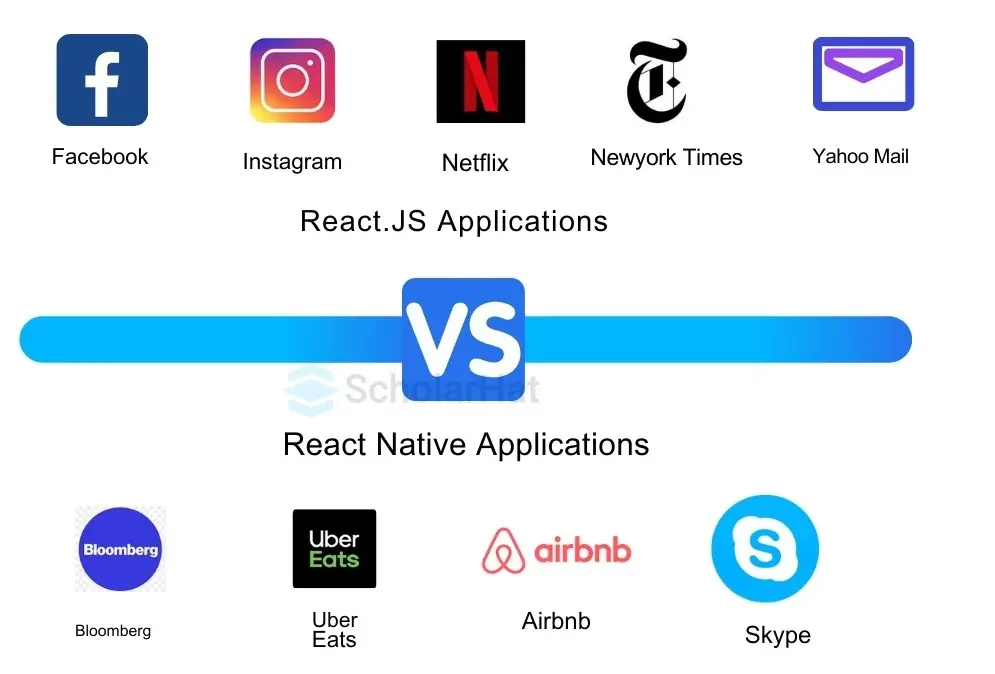Introduction: React vs React Native
React (also known as ReactJS) and React Native are two widely used technologies in the app development industry. The similarity in these names can easily lead to confusion. This blog clarifies the distinctions between them.
React Native and React are the favourite front-end frameworks to develop both UI and applications. React Native is intended for creating cross-platform native mobile apps whereas React focuses on developing only web applications or web pages. This article puts React Native and React side by side, to see how popular they have been in 2024 when it comes to better opportunities at jobs, higher adoption rates, and community support.
Understanding React & Why We Use It
Facebook developed React to enhance interactivity on what were traditionally static web pages. Once released as open-source software, it allowed developers to adopt and build upon it.
Supported by Facebook, React benefits from robust backing and extensive documentation, making it easy for any team with JavaScript expertise to adopt.
React developers can seamlessly integrate plugins and libraries into existing code, enabling them to build fast, scalable, and efficient web applications. With its introduction to front-end development, React has reintroduced essential server-side logic.
By leveraging React development services, we can address the customers’ needs by providing progressive web apps, single-page applications, and static websites.
Understanding the Basics of React Native
React Native is a natural extension of React, evolving its principles to enable mobile app development. It is a cross-platform mobile application structure that enables the development of a mobile app using the same source code. This JavaScript framework allows the creation of mobile apps that render natively on various platforms, including iOS and Android.
React Native is based on the fundamental concepts of React, but it includes specialized components designed specifically for developing mobile app. Although they share similar core characteristics, the differences between React and React Native are significant.
Let us understand the difference between these two more thoroughly. Both technologies are popular in their individual domains. Additionally, the cost of React Native development can vary based on the app’s functionality and requirements.
In contrast, learning the languages required for native app development takes longer. A team already proficient in React can transition to a React Native project in less than two weeks, making it a more efficient choice.
Difference Between React and React Native
So far what we have learnt is:
- React Native is used for building native mobile apps for iOS and Android using React while React is used for building web applications, web pages and complex web UIs using React.
- React Native compiles the code to the native iOS/Android platform while React compiles to plain JavaScript and supports web platforms.
- React builds interactive user interfaces using a combination of HTML, CSS, and JavaScript. On the contrary, React Native leverages native UI components and APIs to develop mobile apps.
Like most siblings, React and React Native share common functionalities and features, but they also have their fair share of differences.
This analogy holds true for these closely related technologies. Now, let’s examine the key differences between React and React Native.
| React | React Native | |
| Rendering Targets | React leverages the Virtual DOM to deliver an exceptional user experience. This virtual representation of the real DOM is a game-changer for React, optimizing performance and efficiency. It enables quick updates for dynamic UIs, offering faster performance and an improved user experience compared to traditional DOM updates. | React Native employs APIs to display User Interface components that are reusable across both Android and iOS platforms. It utilizes Java APIs for rendering Android components, native APIs for core functionality and Objective-C for creating iOS components when rendering the user interface. |
| Installation Process | React is a JavaScript library, so one simply needs to integrate the React library into the HTML page using the <script>tag
|
To develop an app using React Native, one must have a development environment like Android Studio for Android or Xcode for iOS. |
| Performance
|
Fast and efficient | Closer to native performance, as it uses native components |
| Technology Base
|
It is just a JavaScript library | It is a framework that uses React to create mobile UI. Since it builds upon all the features of React, it offers many advantages and utilizes declarative components, like React. |
| Feasibility
|
React merges HTML and JavaScript technologies, primarily to streamline CSS integration. This method tackles frequent problems in CSS development, such as conflicts in global namespaces and the isolation of variables/scope. | If one wants to add more components and features to an existing app without overhauling the entire code, React Native lets one integrate native components into the app’s existing codebase. |
| Compatibility
|
It was designed with Search Engine Optimization (SEO) in mind, rendering on the user’s server using Node. | React Native is tailored for building mobile UIs. Although it is entirely UI-driven, it operates more like a JavaScript library than a traditional framework, resulting in highly responsive interfaces, smoother experiences, and faster loading times. |
| Syntax
|
With React, one can write code in JavaScript, which renders HTML-like components using tags such as <p>, <div>, and <h1>. It utilizes JSX, a special syntax extension for JavaScript that combines markup and logic in a way that may seem unconventional at first | React Native uses a distinct syntax, rendering native components with tags like <View>, <Text>, and <Image> instead of HTML-like components. |
| Components
|
Components based on HTML and CSS | Native Components |
| Navigation
|
It utilizes React Router for navigating between web pages. | It comes with an integrated Navigator library for mobile app navigation. |
| Debugging
|
Easy and straightforward | Can be more difficult due to native code integration |
| Customization
|
High level of customization options | Limited customization options compared to native development |
Similarities Between React and React Native
Below is a table showing similarities between React and React Native.
| Feature | Similarity |
| Core Principles | Both utilize core principles like components, state, and props for building user interfaces. |
| JavaScript | Both use JavaScript as the programming language for building applications. |
| Component-Based Architecture | Both encourage the use of reusable components for UI construction, making code more modular and maintainable. |
| Declarative UI | Both employ a declarative method for UI development, making the code more consistent and simpler to troubleshoot. |
| Development Experience | Both provide an enhanced development experience, featuring capabilities like hot reloading, which lets developers view changes in real-time without losing the application state. |
| React Ecosystem | Both leverage the React ecosystem, which includes a vast array of tools, libraries, and community support. |
| Learn Once, Write Anywhere | Both embody the principle of “Learn Once, Write Anywhere,” allowing developers to apply their React knowledge across web and mobile platforms, though with platform-specific implementations. |
Thus, React and React Native share a common foundation, including the use of JavaScript and a component-based architecture. They fulfil different roles within the development ecosystem.
Advantages of React
- Easy to Learn and Use: React is easy to grasp for developers with a JavaScript background, making it easier for them to start building web apps.
- Simplified Dynamic Web Applications: React makes it easy to create dynamic web apps by reducing complex code and offering greater functionality with less code.
- Reusable Components: React applications are composed of multiple components that each have logic, so the first point makes perfect sense. These reusable components save considerable time in both development and maintenance
- Performance Improvement: Having the Virtual DOM speeds up performance, when any manipulation must be done on the real DOM it happens on memory first and then updates so applications feel smoother and faster.
- Support of Handy Tools: React provides a collection of useful tools that make it easy to manage and inspect the state and props of components.
Disadvantages of React
- Rapid Development Pace: Continuous updates can make it difficult for developers to stay current and adapt to new practices.
- Poor Documentation: The fast pace of updates can lead to insufficient documentation, requiring developers to write their own instructions as they adapt.
- Limited to UI Layers: React focuses only on the UI layer, necessitating the integration of other technologies for complete development.
- SEO Challenges: Traditional JavaScript frameworks can struggle with SEO but React mitigates this issue by allowing applications to run on the server.
- Dependency on JavaScript Library: While gaining popularity, React’s reliance on JavaScript libraries can be both a strength and a limitation for developers.
- Testing Opportunities: React applications are easy to test, with native tools available for debugging and verification.
Advantages of React Native
- Cross-Platform Usage: React Native allows developers to “write once, run everywhere,” supporting both Android and iOS.
- Class Performance: Code is compiled into native code, ensuring consistent functionality across platforms.
- JavaScript Usage: Developers can leverage their JavaScript knowledge to build native mobile apps.
- Community Support: A large community provides ample resources and answers to common questions.
- Hot Reloading: Changes made in the code are instantly visible during development, allowing for immediate feedback.
- Continuous Improvement: The community actively works on enhancing support for new features on iOS and Android.
- Native Components: While some platform-specific code may be needed for native functionalities, React Native supports native components.
- Uncertain Longevity: While backed by Facebook, there are concerns about the framework’s future, although its growing popularity makes it less likely to be abandoned.
Disadvantages of React Native
- Long Initialization Times: React Native can take longer to initialize, even on high-end devices, which may affect development efficiency.
- Security Gaps: As an open-source framework, React Native may have security vulnerabilities, making it less ideal for sensitive applications like banking.
- Limited or Restricted Access to Native APIs: Some native features and functionalities may not be fully accessible or supported, potentially limiting the app’s complexity.
- Challenging Learning Curve: For those new to app development, mastering React Native can be difficult and may require significant effort.
React Native VS React: Applications:

Tools Similar to React and React Native
Here are some tools that offer similar functionality and applications to React and React Native:
- Angular: An open-source web application framework based on TypeScript.
- Vue.js: A progressive JavaScript framework for creating user interfaces.
- Ionic: A cross-platform framework that allows developers to build mobile apps using popular web technologies.
- Ember.js: A framework designed for creating ambitious web applications, emphasizing convention over configuration and customization.
- NativeScript: A free and open-source framework for building native applications with JavaScript or TypeScript.
- Xamarin: A cross-platform framework for developing mobile apps using traditional development platforms.
- Flutter: A mobile app SDK for creating high-performance, high-fidelity applications for various mobile operating systems from a single codebase.
- Svelte: A JavaScript framework based on components for building web applications.
React vs. React Native: Which One Should You Choose for Your Next Project?
We hope that this blog post has helped clarify the differences between React and React Native.
React is a great option for applications that demand a high-performance, dynamic, and responsive user interface (UI), whereas React Native is best suited for mobile apps that require a fully native experience.
Which one is chosen depends on the specific needs of the project.
Speed and usability are essential considerations for developers when selecting the right technology for front-end development. Additionally, improved SEO should be one of the primary objectives. Therefore, when hiring dedicated developers, ensure they prioritize these criteria by leveraging React and React Native effectively.
Know More: Embedded Software Development Services












